Find these visible planets in September 2021: Venus, Mercury, Jupiter, Saturn, Mars, Neptune
Try Stellarium for a precise view from your location.
For more specific information on planet rise and set times from your location, consult either The Old Farmer’s Almanac (U.S. and Canada) or timeanddate.com (worldwide); or see EarthSky’s list of recommended almanacs.
Visible planets, the moon and more

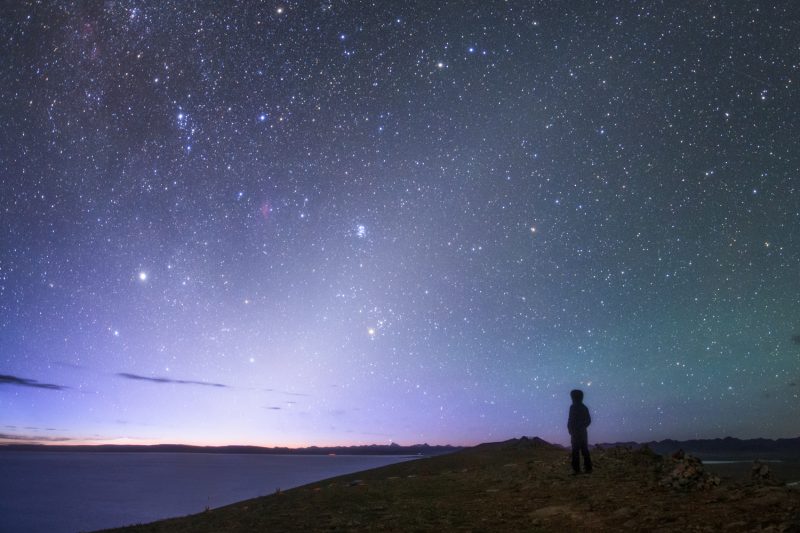



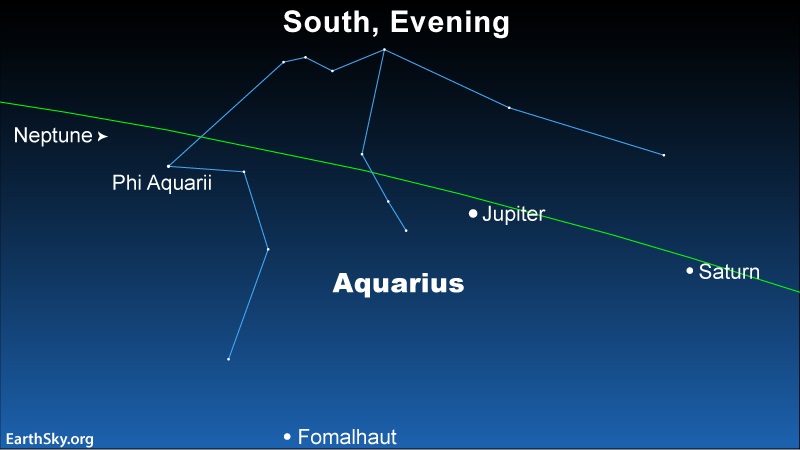
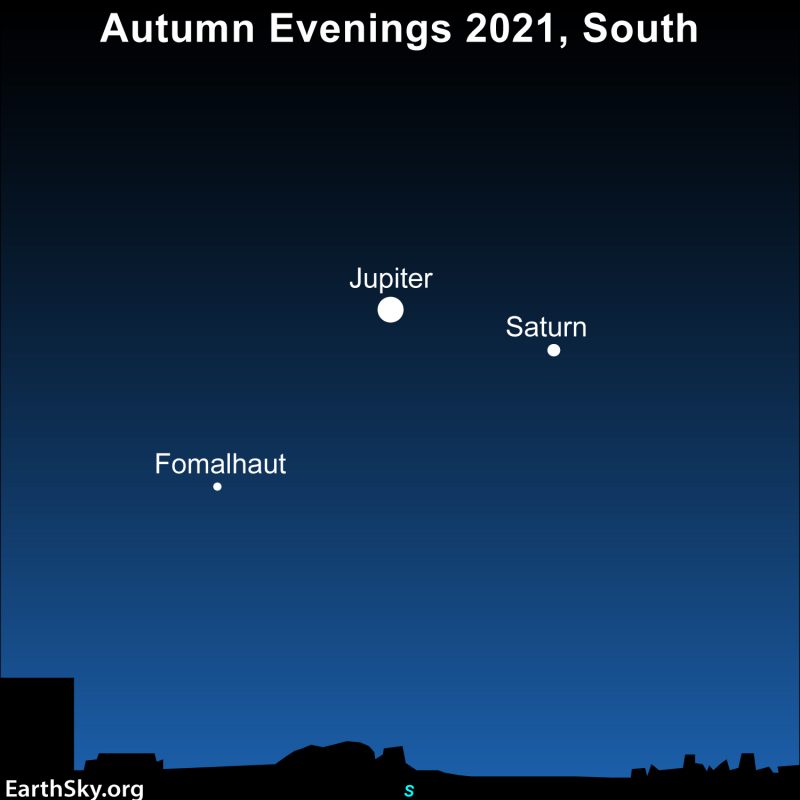
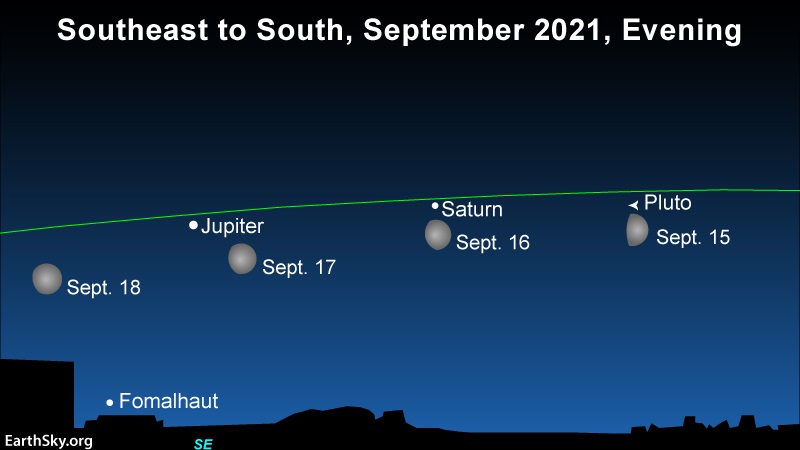
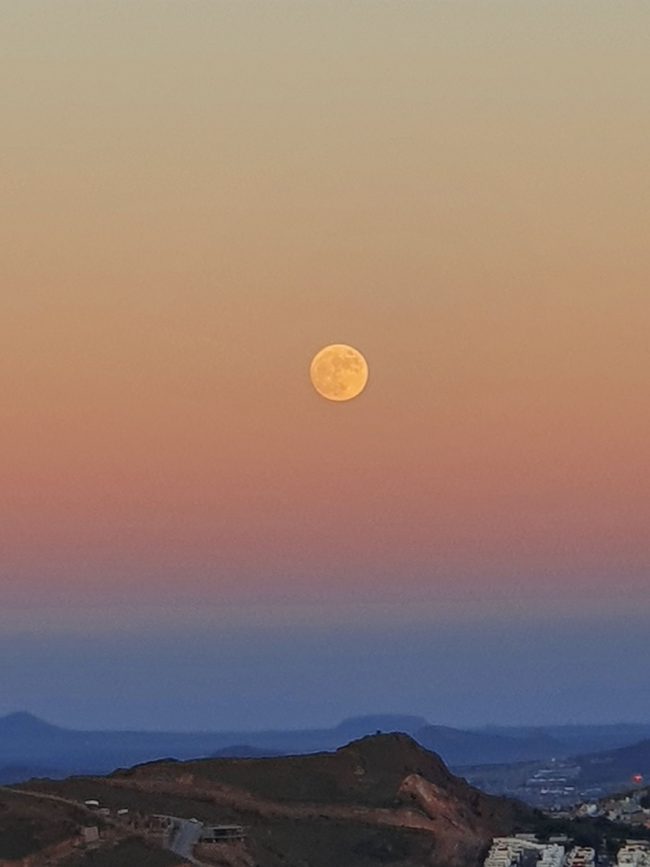
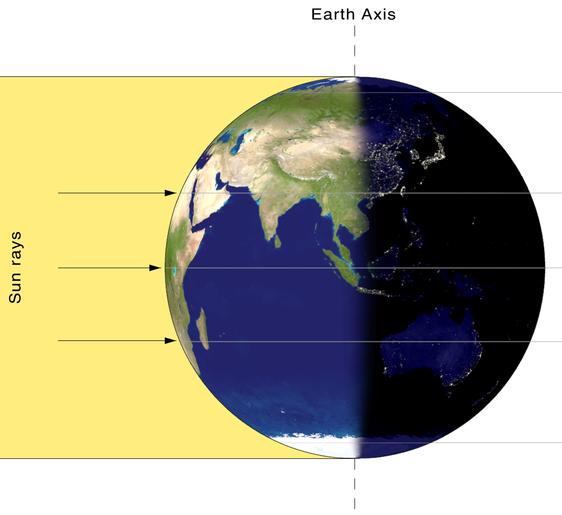
Planets in September 2021
Venus begins September 2021 at a good distance from the sunset (40 degrees from the sun). But for the Northern Hemisphere, the autumn angle of the ecliptic keeps Venus low in the west after sunset. Still, Venus is exceedingly bright. It starts this month at magnitude -3.9 and brightens a bit throughout the month. Venus passes 1.7 degrees north of Spica on September 5. The waxing crescent moon passes 4 degrees to its north on the North American evening of September 9. Venus will reach a greatest elongation on October 29 (47 degrees from the sun). But, even then, for us in the north, it’ll still hang low in the western twilight sky. Meanwhile, Venus is glorious this month from Earth’s Southern Hemisphere. Venus will shine boldly in the evening sky for the rest of this year. It’ll attain greatest brilliance as the evening “star” around December 3-4, 2021. Then it’ll shine at magnitude -4.5! Circle early December on your calendar, and see if it’s true that Venus can cast a shadow on a dark night.
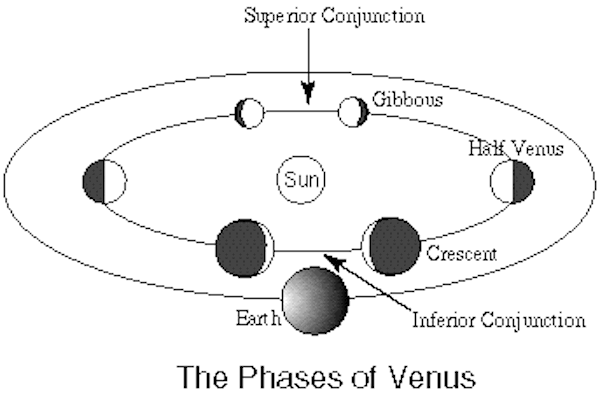
Mercury continues its best evening apparition of the year for the Southern Hemisphere. For us in the north, the autumn angle of the ecliptic will make Mercury difficult or impossible to see. The Observer’s Handbook describes a “long (relatively) languid loop” for Mercury, east of the sun. The planet comes to its once-in-88-days aphelion (farthest point fron the sun) on September 6. And it reaches greatest elongation east (farthest east of the sun on the sky’s dome, or visible in the west after sunset on September 14 at about 04:00 UTC. At that time, mid-September 2021, Mercury will shine at magnitude 0.1. The thin crescent moon passes 6 degrees to Mercury’s north on September 8. Again, great for the Southern Hemisphere, extremely poor for the Northern Hemisphere.
Jupiter was at opposition on August 19-20. Saturn was at opposition on August 1-2. Opposition marks the middle of the best time of year to see a planet. These two are now up in the east at nightfall and are exceedingly prominent nearly all night. Both are bright. Saturn appears as a bright, golden, steady “star,” shining as brightly as the sky’s brightest stars at magnitude 0.3. But Jupiter is much brighter at magnitude -2.6. Jupiter and Saturn are still near each other on the sky’s dome. That’s many months after their great conjunction, when Jupiter passed Saturn in the race of the planets, which happened in December 2020.
Mars is too close to the sun to be seen in September 2021. It will pass behind the sun on October 8. When will you next see Mars? Perhaps in late November 2021, when it begins to emerge in the eastern twilight before sunrise. Afterwards, Mars will have a months-long period of appearing faint and inconspicuous in our eastern predawn sky. During that time, Earth will be steadily plowing ahead of Mars in its smaller, faster orbit around the sun. But, inevitably, Earth will catch up to Mars and pass it on the inside track. That will happen next on December 8, 2022. And then Mars will be at its brightest for all of 2022. And it’ll be up all night.
Read more: What to expect from Mars in 2021
Neptune reaches its yearly opposition – when Earth flies between this outer planet and the sun – on September 14, 2021. Opposition marks the middle of the best time of year to see an outer planet. And indeed Neptune is generally closest to Earth for the year throughout September. But, because it’s the outermost known major planet in our solar system, it’s still some 4 light-hours away. That’s 28.9 astronomical units (AU), or Earth-sun distances. And thus Neptune is faint. It shines at magnitude +7.8 in September 2021, way beyond the limit for viewing with the unaided eye. You’ll need a dark sky for Neptune. Plus, you’ll need a detailed chart; TheSkyLive has one. And you’ll need strong binoculars securely mounted on a steady tripod, or a telescope. If you can find it, you’ll see that Neptune has a 2.3″ disk this month. That’s minutely larger than usual.
Some resources to enjoy
Try Stellarium for precise views from your location
Try TheSkyLive for precise views from your location
Click here for recommended almanacs to find out precise rise and set times
Translate Universal Time (UTC) to your time
Ecliptic is the sun’s path in our sky
Which ones are the visible planets?
In their outward order from the sun, the five bright planets are Mercury, Venus, Mars, Jupiter and Saturn. These are the planets easily visible without an optical aid. They’re the planets watched by our ancestors since time immemorial. These planets do appear bright in our sky. They are typically as bright as – or brighter than – the brightest stars. Plus, these relatively nearby worlds tend to shine with a steadier light than the distant, twinkling stars.
You can spot them, and come to know them as faithful friends, if you try.

Bottom line: All you need to know about how to find the bright planets of the solar system during the month of September 2021.
Don’t miss anything. Subscribe to EarthSky News by email
Visit EarthSky’s Best Places to Stargaze to find a dark-sky location near you.
Help EarthSky keep going! Donate now.
Post your planet photos at EarthSky Community Photos.
The post Visible planets – and more – in September 2021 first appeared on EarthSky.
from EarthSky https://ift.tt/2SL2h7q
Find these visible planets in September 2021: Venus, Mercury, Jupiter, Saturn, Mars, Neptune
Try Stellarium for a precise view from your location.
For more specific information on planet rise and set times from your location, consult either The Old Farmer’s Almanac (U.S. and Canada) or timeanddate.com (worldwide); or see EarthSky’s list of recommended almanacs.
Visible planets, the moon and more










Planets in September 2021
Venus begins September 2021 at a good distance from the sunset (40 degrees from the sun). But for the Northern Hemisphere, the autumn angle of the ecliptic keeps Venus low in the west after sunset. Still, Venus is exceedingly bright. It starts this month at magnitude -3.9 and brightens a bit throughout the month. Venus passes 1.7 degrees north of Spica on September 5. The waxing crescent moon passes 4 degrees to its north on the North American evening of September 9. Venus will reach a greatest elongation on October 29 (47 degrees from the sun). But, even then, for us in the north, it’ll still hang low in the western twilight sky. Meanwhile, Venus is glorious this month from Earth’s Southern Hemisphere. Venus will shine boldly in the evening sky for the rest of this year. It’ll attain greatest brilliance as the evening “star” around December 3-4, 2021. Then it’ll shine at magnitude -4.5! Circle early December on your calendar, and see if it’s true that Venus can cast a shadow on a dark night.

Mercury continues its best evening apparition of the year for the Southern Hemisphere. For us in the north, the autumn angle of the ecliptic will make Mercury difficult or impossible to see. The Observer’s Handbook describes a “long (relatively) languid loop” for Mercury, east of the sun. The planet comes to its once-in-88-days aphelion (farthest point fron the sun) on September 6. And it reaches greatest elongation east (farthest east of the sun on the sky’s dome, or visible in the west after sunset on September 14 at about 04:00 UTC. At that time, mid-September 2021, Mercury will shine at magnitude 0.1. The thin crescent moon passes 6 degrees to Mercury’s north on September 8. Again, great for the Southern Hemisphere, extremely poor for the Northern Hemisphere.
Jupiter was at opposition on August 19-20. Saturn was at opposition on August 1-2. Opposition marks the middle of the best time of year to see a planet. These two are now up in the east at nightfall and are exceedingly prominent nearly all night. Both are bright. Saturn appears as a bright, golden, steady “star,” shining as brightly as the sky’s brightest stars at magnitude 0.3. But Jupiter is much brighter at magnitude -2.6. Jupiter and Saturn are still near each other on the sky’s dome. That’s many months after their great conjunction, when Jupiter passed Saturn in the race of the planets, which happened in December 2020.
Mars is too close to the sun to be seen in September 2021. It will pass behind the sun on October 8. When will you next see Mars? Perhaps in late November 2021, when it begins to emerge in the eastern twilight before sunrise. Afterwards, Mars will have a months-long period of appearing faint and inconspicuous in our eastern predawn sky. During that time, Earth will be steadily plowing ahead of Mars in its smaller, faster orbit around the sun. But, inevitably, Earth will catch up to Mars and pass it on the inside track. That will happen next on December 8, 2022. And then Mars will be at its brightest for all of 2022. And it’ll be up all night.
Read more: What to expect from Mars in 2021
Neptune reaches its yearly opposition – when Earth flies between this outer planet and the sun – on September 14, 2021. Opposition marks the middle of the best time of year to see an outer planet. And indeed Neptune is generally closest to Earth for the year throughout September. But, because it’s the outermost known major planet in our solar system, it’s still some 4 light-hours away. That’s 28.9 astronomical units (AU), or Earth-sun distances. And thus Neptune is faint. It shines at magnitude +7.8 in September 2021, way beyond the limit for viewing with the unaided eye. You’ll need a dark sky for Neptune. Plus, you’ll need a detailed chart; TheSkyLive has one. And you’ll need strong binoculars securely mounted on a steady tripod, or a telescope. If you can find it, you’ll see that Neptune has a 2.3″ disk this month. That’s minutely larger than usual.
Some resources to enjoy
Try Stellarium for precise views from your location
Try TheSkyLive for precise views from your location
Click here for recommended almanacs to find out precise rise and set times
Translate Universal Time (UTC) to your time
Ecliptic is the sun’s path in our sky
Which ones are the visible planets?
In their outward order from the sun, the five bright planets are Mercury, Venus, Mars, Jupiter and Saturn. These are the planets easily visible without an optical aid. They’re the planets watched by our ancestors since time immemorial. These planets do appear bright in our sky. They are typically as bright as – or brighter than – the brightest stars. Plus, these relatively nearby worlds tend to shine with a steadier light than the distant, twinkling stars.
You can spot them, and come to know them as faithful friends, if you try.

Bottom line: All you need to know about how to find the bright planets of the solar system during the month of September 2021.
Don’t miss anything. Subscribe to EarthSky News by email
Visit EarthSky’s Best Places to Stargaze to find a dark-sky location near you.
Help EarthSky keep going! Donate now.
Post your planet photos at EarthSky Community Photos.
The post Visible planets – and more – in September 2021 first appeared on EarthSky.
from EarthSky https://ift.tt/2SL2h7q

Aucun commentaire:
Enregistrer un commentaire